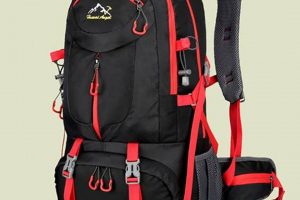These specialized carrying systems are designed for extended outdoor excursions, particularly in mountainous terrain. They typically feature robust construction, ample storage capacity, and advanced suspension systems to distribute weight effectively. One might choose such a pack for multi-day treks or expeditions where self-sufficiency is paramount.
The value of this equipment lies in its ability to facilitate comfortable and efficient load-bearing during demanding physical activities. A well-designed system can significantly reduce strain on the back and shoulders, enhancing endurance and overall experience. Historically, the evolution of these systems reflects advancements in materials science and ergonomic design principles, leading to lighter and more supportive options.
The following sections will delve into key considerations for selecting suitable equipment, including capacity, features, materials, and fit. A comprehensive understanding of these factors is essential for optimizing comfort and performance on the trail.
Essential Considerations for Backpack Selection
Selecting the appropriate carrying system for high-altitude treks requires careful consideration of several factors to ensure comfort, efficiency, and safety during prolonged expeditions.
Tip 1: Capacity Assessment. Evaluate the intended duration of trips and the corresponding gear requirements. Insufficient volume necessitates compromises, while excessive space can lead to instability and inefficient weight distribution. Typical capacities range from 50 to 75 liters for multi-day excursions.
Tip 2: Suspension System Evaluation. Examine the frame structure, shoulder straps, hip belt, and back panel. An effective suspension system transfers the majority of the load to the hips, reducing strain on the back and shoulders. Adjustable torso lengths are crucial for achieving a proper fit.
Tip 3: Material Durability. Prioritize robust fabrics like ripstop nylon or Cordura. These materials offer resistance to abrasion, tearing, and water penetration, essential for withstanding harsh environmental conditions. Consider the denier rating, a measure of fabric thickness and durability.
Tip 4: Feature Prioritization. Assess the need for specific features such as external attachment points for trekking poles or ice axes, hydration reservoir compatibility, and multiple access points to the main compartment. Avoid unnecessary features that add weight and complexity.
Tip 5: Fit Optimization. A proper fit is paramount for comfort and performance. Visit a specialty outdoor retailer to be professionally fitted and experiment with different models. Load the pack with weight during the fitting process to simulate real-world conditions.
Tip 6: Weight Consideration. Minimize the pack’s empty weight without sacrificing durability or features. Lightweight materials and minimalist designs can significantly reduce overall burden, especially on extended trips.
Tip 7: Weather Resistance. While not all backpacks are fully waterproof, a water-resistant coating or included rain cover is essential for protecting gear from precipitation. Consider investing in waterproof stuff sacks for sensitive items.
Selecting a suitable carrying system involves a thorough assessment of individual needs, desired features, and fit. Prioritizing durability, weight distribution, and weather resistance will contribute to a more enjoyable and safe hiking experience.
The subsequent discussion will address the maintenance and care required to extend the lifespan of the selected carrying system.
1. Capacity and volume
Capacity and volume are fundamental parameters when selecting equipment intended for high-altitude wilderness travel. These two attributes directly determine the amount of gear and supplies a hiker can carry, influencing trip duration and the level of self-sufficiency achievable. An undersized carrying system necessitates difficult choices regarding essential equipment, potentially compromising safety and comfort. Conversely, an oversized container, even if not fully loaded, adds unnecessary weight and bulk, increasing fatigue and reducing agility on challenging terrain. Therefore, accurate estimation of gear volume requirements, paired with an understanding of optimal weight limits, forms the basis of proper capacity selection.
Consider a three-day trek in the Sierra Nevada during the shoulder season. The hiker must accommodate layers of clothing for fluctuating temperatures, a sleeping bag rated for near-freezing conditions, a tent, cooking equipment, food, water, and essential safety items. A pack with a capacity of 50 liters might prove insufficient, forcing the hiker to sacrifice important items like extra insulation or a more substantial first-aid kit. Upgrading to a 65- or 70-liter model would provide the necessary space without exceeding reasonable weight limits, ensuring a safer and more comfortable experience. This demonstrates the direct causal relationship between available capacity and the ability to adequately prepare for the demands of the environment. Furthermore, proper volume distribution within the carrying system is crucial. Strategically packing heavier items closer to the hiker’s center of gravity improves balance and reduces strain.
Ultimately, selecting equipment with appropriate capacity and volume is not merely a matter of convenience; it is a critical component of risk management in backcountry settings. Accurately assessing gear requirements, understanding the limitations of available space, and practicing efficient packing techniques contribute significantly to a safe and successful high-altitude hiking experience. Ignoring these considerations can lead to discomfort, reduced performance, and potentially dangerous situations.
2. Suspension Mechanics
The suspension system represents a critical engineering component within load-bearing equipment designed for extended wilderness travel. Its primary function is to efficiently transfer the weight of carried gear from the shoulders and back to the hips, thereby mitigating strain and enhancing comfort during prolonged physical exertion. Effective suspension mechanics are paramount for optimizing load distribution and minimizing the risk of injury in demanding high-altitude environments.
- Frame Structure
The internal or external frame provides the structural backbone of the suspension system. Frames, commonly constructed from aluminum or composite materials, dictate the shape and rigidity of the load-bearing platform. A well-designed frame effectively transfers weight to the hip belt, preventing excessive pressure on the shoulders. Consider the Osprey Aether/Ariel series, which employs a LightWire frame to balance load transfer and torsional flex, adapting to body movement while maintaining stability.
- Shoulder Straps
Shoulder straps are responsible for maintaining the pack’s vertical position and contributing to overall load stability. Contoured designs, padded construction, and adjustability are essential for achieving a comfortable and secure fit. The Arc’teryx Bora AR series features thermo-molded shoulder straps that conform to the user’s anatomy, minimizing pressure points and maximizing ventilation. Inadequate shoulder strap design can lead to chafing, muscle fatigue, and compromised balance.
- Hip Belt
The hip belt serves as the primary weight-bearing element of the suspension system. Its purpose is to transfer the majority of the load to the hips, the body’s strongest weight-bearing structure. Effective hip belts are contoured, padded, and adjustable to accommodate varying body shapes and sizes. The Gregory Baltoro/Deva series incorporates pivoting hip belts that move with the body, reducing friction and improving comfort during dynamic movements. A poorly designed hip belt can result in inadequate weight transfer and increased strain on the back and shoulders.
- Back Panel
The back panel provides cushioning, ventilation, and structural support. Designs range from simple padded panels to complex mesh systems that promote airflow and reduce perspiration. The Deuter Aircontact series features a multi-layer construction that combines padding with ventilation channels, minimizing contact points and maximizing breathability. An inadequate back panel can lead to discomfort, overheating, and restricted range of motion.
These interconnected components of the suspension system work in concert to provide a stable, comfortable, and efficient means of carrying substantial loads over extended distances. The interplay between frame structure, shoulder straps, hip belt, and back panel dictates the overall performance of the equipment and its ability to mitigate the physiological demands of high-altitude hiking. Proper adjustment and fit are critical for realizing the full benefits of a well-designed suspension system.
3. Material Durability
The inherent resilience of materials used in the construction of wilderness carrying systems is a paramount factor determining longevity, reliability, and overall suitability for demanding high-altitude environments. Material selection directly influences a carrying systems ability to withstand abrasion, tearing, water exposure, and the stresses associated with carrying heavy loads over rugged terrain.
- Fabric Strength and Denier Rating
The denier rating, a unit of measure indicating the linear mass density of fibers, serves as a primary indicator of fabric strength. Higher denier ratings generally correspond to increased resistance to tearing and abrasion. For equipment intended for challenging environments, fabrics such as high-denier ripstop nylon or Cordura are often employed. These materials provide a robust defense against punctures and abrasions caused by rocks, branches, and other environmental hazards. The choice of fabric directly impacts the equipment’s ability to endure the rigors of extended wilderness travel.
- Coating and Water Resistance
Water resistance is a critical attribute for maintaining the integrity of carried gear in inclement weather conditions. Many high-quality systems incorporate durable water repellent (DWR) coatings or waterproof laminates to prevent moisture penetration. These treatments enhance the fabric’s ability to shed water, protecting sensitive contents such as sleeping bags, electronics, and clothing. While not always fully waterproof, these measures significantly reduce the risk of water damage and maintain the functionality of essential equipment.
- Seam Construction and Reinforcement
The integrity of seams directly influences the overall durability and water resistance of the carrying system. Reinforced stitching, taped seams, and bar-tacking at stress points enhance the structural integrity and prevent premature failure. These construction techniques distribute stress evenly across seams, reducing the likelihood of tearing or separation under heavy loads. Careful attention to seam construction is essential for ensuring the long-term reliability of the equipment in demanding conditions.
- Component Quality and Longevity
Beyond the primary fabric, the durability of zippers, buckles, straps, and other components contributes significantly to the overall lifespan of the system. High-quality zippers, such as those manufactured by YKK, offer increased resistance to breakage and corrosion. Robust buckles and straps ensure secure closure and load-bearing capability. The use of durable, corrosion-resistant hardware is essential for maintaining the functionality and reliability of the equipment over time.
The selection of appropriate materials and construction techniques is a critical factor in determining the suitability of a system for high-altitude hiking. Prioritizing durability and weather resistance ensures that the equipment can withstand the rigors of the environment, protecting valuable gear and contributing to a safer and more enjoyable wilderness experience. Neglecting these considerations can lead to premature equipment failure and potentially dangerous situations.
4. Weather Resistance
Weather resistance constitutes a critical performance parameter for load-bearing equipment specifically designed for high-altitude wilderness travel. The unpredictable and often severe weather conditions encountered in mountainous regions necessitate robust protection for carried gear and the individual relying upon it. A carrying system’s ability to withstand precipitation, wind, and temperature fluctuations directly impacts the safety, comfort, and overall success of extended expeditions.
- Fabric Waterproofing and Coatings
The primary defense against moisture ingress lies in the fabric’s inherent water resistance, augmented by specialized coatings. Durable water repellent (DWR) treatments create a hydrophobic surface, causing water to bead and roll off rather than soaking into the material. Waterproof membranes or laminates, such as those utilizing Gore-Tex or similar technologies, provide an impermeable barrier, preventing water penetration even under prolonged exposure. The efficacy of these treatments is crucial; consider a scenario where a sudden downpour soaks through an unprotected pack, rendering sleeping bags and clothing damp, significantly increasing the risk of hypothermia.
- Seam Sealing and Construction
Seams represent potential points of water entry, necessitating meticulous sealing techniques. Taped seams, where waterproof tape is applied over sewn seams, create a continuous barrier against moisture. Reinforced stitching and strategic seam placement minimize stress and reduce the likelihood of seam failure. A poorly constructed seam can compromise the overall water resistance, allowing water to seep into the main compartment and damage sensitive equipment. High-stress areas, such as attachment points for straps and buckles, require particular attention to seam integrity.
- Waterproof Zippers and Closures
Zippers and closures offer another avenue for water penetration. Waterproof zippers, featuring interlocking teeth and a tight seal, provide a reliable barrier against moisture. Storm flaps, overlapping fabric panels that cover zippers and closures, offer an additional layer of protection. The effectiveness of these closures is paramount; imagine attempting to retrieve essential gear during a blizzard, only to find that the zipper has failed, exposing the contents to snow and wind. Robust and reliable closures are essential for maintaining the integrity of the carried gear.
- Pack Covers and Rain Protection
As a supplementary measure, many carrying systems incorporate integrated or detachable rain covers. These covers, typically constructed from lightweight waterproof materials, provide an extra layer of protection during heavy precipitation. A well-designed rain cover fits snugly around the pack, preventing water from pooling and seeping into vulnerable areas. While not a substitute for inherent water resistance, a rain cover offers an added level of security in unpredictable weather conditions. Furthermore, the strategic use of waterproof stuff sacks within the main compartment provides an additional layer of protection for sensitive items, safeguarding them from moisture even if the outer layers are compromised.
The integration of these weather-resistant features directly contributes to the performance and reliability. A carrying system that effectively protects its contents from moisture enables hikers to maintain a dry and comfortable environment for essential gear, reducing the risk of hypothermia, equipment malfunction, and overall discomfort. Therefore, careful consideration of weather resistance is a critical aspect of selecting a system suitable for the demanding conditions encountered in mountainous regions.
5. Accessibility features
Accessibility features within wilderness carrying systems, particularly those intended for high-altitude environments, directly impact the efficiency and safety of gear retrieval and management. These design elements facilitate rapid access to essential items without necessitating extensive unpacking, a crucial consideration in dynamic and potentially hazardous situations.
- External Pockets and Compartments
Strategically placed external pockets and compartments provide immediate access to frequently used items such as water bottles, maps, snacks, and first-aid supplies. These compartments minimize the need to open the main compartment, preserving the organization of internal gear and preventing heat loss in cold conditions. A side stretch pocket, for example, allows retrieval of a water bottle without removing the equipment, while a dedicated map pocket on the top lid ensures quick navigation reference. Their utility is maximized when the design allows for operation with gloved hands.
- Multiple Access Points to the Main Compartment
Beyond the traditional top-loading design, alternative access points such as front panel zippers or side zippers enhance gear retrieval options. Front panel access allows the user to unpack items from the middle or bottom of the pack without disturbing items stored above. Side zippers provide quick access to specific compartments within the main body. Consider a scenario where a hiker needs to access a mid-layer garment during a sudden temperature drop. A front panel zipper eliminates the need to unpack the entire contents, minimizing exposure and conserving time.
- Attachment Points and Lash Tabs
External attachment points and lash tabs provide secure and accessible storage for items that do not fit within the main compartment or require quick deployment. These features allow for the attachment of trekking poles, ice axes, sleeping pads, and other bulky items. Properly utilized lash tabs prevent these items from shifting or detaching during movement. A well-designed system includes reinforced attachment points and adjustable straps to accommodate various gear configurations. For instance, ice axes can be securely fastened to the exterior, providing immediate access in icy terrain.
- Internal Organization and Dividers
Internal organization systems, including dividers, pockets, and straps, contribute to efficient gear management and accessibility. Dividers separate the main compartment into distinct zones, preventing items from shifting and facilitating quick identification. Internal pockets provide dedicated storage for smaller items, such as headlamps, electronics, and toiletries. Compression straps secure the contents, minimizing bulk and preventing items from shifting during movement. Proper internal organization enhances efficiency by minimizing the time required to locate and retrieve specific items.
The integration of these accessibility features directly enhances the usability and functionality of wilderness carrying systems. By providing convenient access to essential gear, these design elements contribute to improved efficiency, safety, and overall comfort during high-altitude hiking and mountaineering expeditions. Therefore, careful consideration of accessibility features is a critical aspect of selecting equipment suited for demanding outdoor environments.
Frequently Asked Questions
The following section addresses common inquiries regarding the selection, use, and maintenance of load-bearing equipment designed for extended outdoor excursions.
Question 1: What capacity should be considered for a multi-day high-altitude trek?
Capacity is directly proportional to trip duration and gear requirements. Multi-day excursions typically necessitate capacities ranging from 50 to 75 liters. Individual needs will vary based on factors such as season, climate, and personal preferences. Thoroughly assess gear volume prior to selection.
Question 2: How does the suspension system contribute to comfort and performance?
The suspension system distributes the weight of carried gear across the hips and shoulders, mitigating strain and improving balance. Effective suspension mechanics are crucial for reducing fatigue and preventing injuries during prolonged physical activity. Evaluate frame structure, shoulder straps, hip belt, and back panel design.
Question 3: What materials offer optimal durability and weather resistance?
High-denier ripstop nylon and Cordura fabrics provide excellent resistance to abrasion and tearing. Durable water repellent (DWR) coatings or waterproof laminates enhance weather resistance, protecting gear from moisture. Consider seam construction and component quality for long-term reliability.
Question 4: Why are accessibility features important in a wilderness environment?
Accessibility features, such as external pockets, multiple access points to the main compartment, and attachment points, facilitate rapid retrieval of essential items without requiring extensive unpacking. These features improve efficiency and enhance safety in dynamic and potentially hazardous situations.
Question 5: How should a load-bearing system be properly fitted?
A proper fit is paramount for comfort and performance. Measure torso length and hip circumference to determine the appropriate size. Load the pack with weight during the fitting process to simulate real-world conditions. Adjust shoulder straps, hip belt, and sternum strap to achieve a secure and comfortable fit.
Question 6: What maintenance procedures should be followed to prolong the lifespan of the pack?
Regular cleaning, using mild soap and water, removes dirt and grime. Inspect for damage to seams, zippers, and buckles. Repair or replace damaged components promptly. Store the pack in a dry, well-ventilated area away from direct sunlight. Proper maintenance extends the lifespan and ensures continued performance.
Choosing appropriate load-bearing equipment, including understanding of the key design and functional aspects, is paramount. Such understanding helps ensure a safe and positive experience in a wilderness environment.
The following section will provide insights into the future trends and design innovation of these specialized carrying systems.
Conclusion
The preceding analysis elucidates critical aspects of specialized load-bearing equipment, highlighting considerations for capacity, suspension mechanics, material durability, weather resistance, and accessibility. Careful evaluation of these factors is essential for selecting equipment suitable for demanding high-altitude environments.
Continued advancements in materials science and ergonomic design promise further enhancements in the performance and comfort of such equipment. A comprehensive understanding of existing technologies and emerging trends is crucial for making informed decisions that prioritize safety and efficiency in wilderness settings. It is a responsibility of the user to ensure they have the right equipment for the environment.



![Best Target Hiking Backpack [Deals] & Reviews Ultimate Backpack Traveler Guide: Tips, Destinations & Budget Hacks Best Target Hiking Backpack [Deals] & Reviews | Ultimate Backpack Traveler Guide: Tips, Destinations & Budget Hacks](https://backpack-traveler.com/wp-content/uploads/2025/10/th-619-300x200.jpg)



